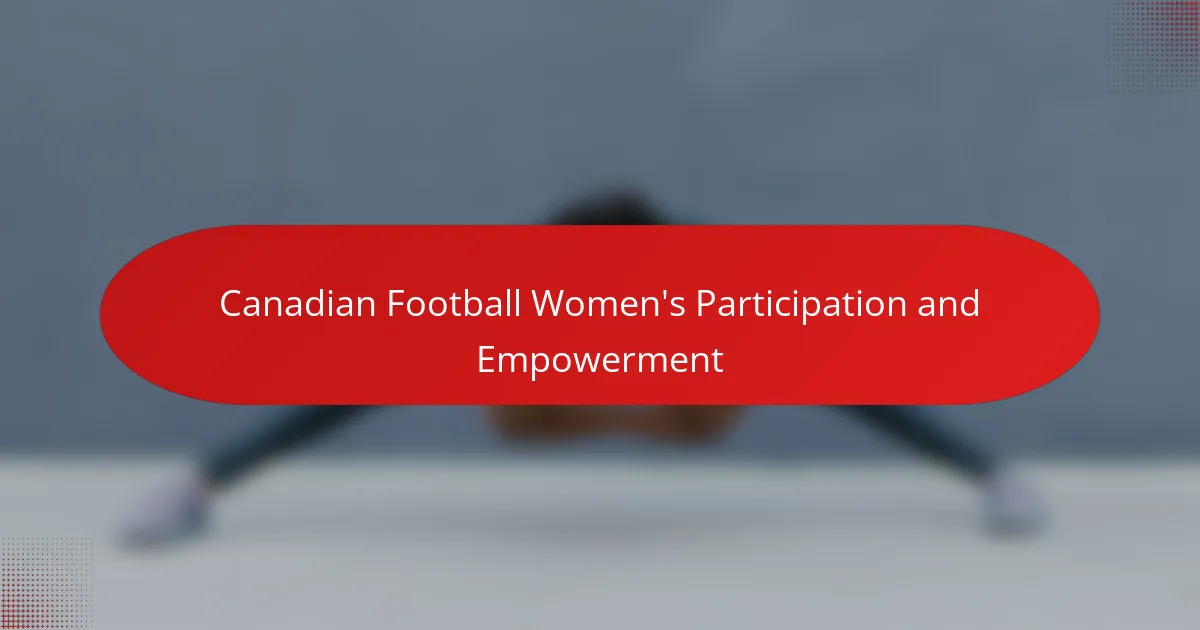Women’s participation in Canadian football enhances community engagement and empowers female athletes. This article explores the barriers women face, the evolving landscape of the sport, and the unique opportunities for leadership and skill development. It highlights the importance of initiatives promoting gender equality and the positive impact of women’s football on social change. The growth of women’s leagues and programs is paving the way for a more inclusive football environment in Canada.

How does women’s participation in Canadian football influence community engagement?
Women’s participation in Canadian football significantly enhances community engagement. It fosters inclusivity, promotes teamwork, and empowers women, creating a supportive environment.
As women take active roles in football, they inspire younger generations and encourage diverse participation. This involvement leads to increased attendance at games and community events, strengthening local bonds.
Furthermore, women’s teams often engage in outreach initiatives, such as hosting clinics and workshops, which further connect with the community. These activities promote health, fitness, and social interaction, emphasizing the positive impact of women’s football on community cohesion.
Overall, the empowerment of women in Canadian football serves as a catalyst for broader community engagement, fostering a culture of support and collaboration.
What are the key benefits of women playing football in local communities?
Women playing football in local communities fosters empowerment, social inclusion, and health benefits. Participation enhances confidence and leadership skills among women. It also promotes teamwork and community cohesion. Additionally, local women’s football initiatives can inspire younger generations, creating a positive cycle of engagement and support.
Which organizations are leading the charge for women’s football in Canada?
The leading organizations for women’s football in Canada include Canada Soccer, Girls Soccer Canada, and the Canadian Women’s National Team. These entities focus on increasing participation and empowering female athletes through development programs and competitive opportunities. Canada Soccer oversees national initiatives and supports grassroots efforts, while Girls Soccer Canada promotes youth engagement. The Canadian Women’s National Team acts as a role model, inspiring young players across the country.

What barriers do women face in participating in Canadian football?
Women face several barriers in participating in Canadian football, including societal stereotypes, lack of access to resources, and limited visibility in the sport. These factors hinder their opportunities for engagement and recognition.
Societal stereotypes often portray football as a male-dominated sport, discouraging women from participating. This perception can lead to a lack of support from families and communities. Additionally, many women face challenges in accessing training facilities and coaching, which limits their skill development.
Limited visibility of women in Canadian football further exacerbates these barriers. Media coverage primarily focuses on men’s leagues, leaving women’s achievements underrepresented. This lack of exposure affects recruitment and sponsorship opportunities, making it difficult for women to pursue football at competitive levels.
Addressing these barriers requires a concerted effort from organizations, communities, and media to promote women’s participation and create an inclusive environment in Canadian football.
How do cultural perceptions impact women’s involvement in sports?
Cultural perceptions significantly influence women’s participation in Canadian football. Traditional views often limit opportunities for women in sports, affecting their empowerment and involvement.
In Canada, initiatives promoting inclusivity and visibility of female athletes are changing these perceptions. Programs like the Women’s Football Alliance provide platforms for women, fostering community support and encouraging participation.
Moreover, societal attitudes towards women’s sports are gradually evolving. Increased media coverage and successful female athletes challenge stereotypes, inspiring younger generations.
As a result, cultural perceptions are shifting, leading to greater acceptance and support for women’s involvement in Canadian football, ultimately empowering them within the sport.
What are the common challenges faced by female athletes in football?
Female athletes in football commonly face challenges such as gender discrimination, lack of funding, limited access to facilities, and inadequate media coverage. These barriers hinder their participation and empowerment in Canadian football. Gender stereotypes often discourage young girls from pursuing the sport, while financial disparities limit opportunities for training and competition. Additionally, female athletes frequently struggle for visibility and recognition compared to their male counterparts, impacting their overall development and career prospects.

How is the landscape of women’s football evolving in Canada?
The landscape of women’s football in Canada is evolving positively, marked by increased participation and empowerment. Participation has risen significantly at grassroots levels, with more girls engaging in youth programs. Professional leagues are emerging, providing platforms for female athletes. Initiatives promoting gender equality in sports are gaining traction, further enhancing visibility and support for women in football. As a result, the overall growth reflects a commitment to fostering talent and creating opportunities for women athletes across the country.
What role do educational institutions play in promoting women’s football?
Educational institutions play a crucial role in promoting women’s football by providing resources, training, and opportunities. They offer structured programs that encourage participation and skill development. Schools and colleges often host competitions, fostering a competitive spirit and teamwork among female athletes.
Moreover, educational institutions can create awareness about the benefits of women’s football, such as enhancing physical fitness and self-confidence. They often collaborate with local clubs and organizations, further expanding access to training and mentorship. This supportive environment cultivates a culture of empowerment, enabling young women to pursue careers in sports and leadership positions within the community.
In Canada, initiatives like the Canadian Women’s National Team programs highlight the impact of educational institutions on women’s football. These programs not only develop athletes but also inspire future generations to engage in sports, ultimately contributing to gender equality in athletics.
Which initiatives are successfully increasing female participation rates?
Initiatives successfully increasing female participation rates in Canadian football include grassroots programs, mentorship opportunities, and targeted outreach campaigns. These efforts aim to create inclusive environments and empower women in the sport.
Grassroots programs focus on introducing girls to football at a young age. Mentorship opportunities connect experienced players with newcomers, promoting skill development and confidence. Targeted outreach campaigns raise awareness about women’s football and its benefits, increasing visibility and participation.
Statistics show that female participation in Canadian football has risen by over 30% in recent years, reflecting the success of these initiatives. As a result, more women are engaging in the sport, contributing to a more diverse and equitable football community.

What unique opportunities exist for women in Canadian football?
Women in Canadian football have unique opportunities for leadership, skill development, and community engagement. Programs like the Women’s National Team and various grassroots initiatives promote female participation. Scholarships and mentorship programs further empower women in sports. As a result, women can break barriers and inspire future generations in football.
How do mentorship programs impact aspiring female football players?
Mentorship programs significantly enhance the participation and empowerment of aspiring female football players in Canada. They provide guidance, support, and networking opportunities that foster skill development and confidence.
These programs often connect young athletes with experienced players and coaches. As a result, participants gain insights into training techniques, game strategies, and career pathways. Research indicates that mentorship can lead to increased retention rates in sports, with female players feeling more valued and motivated.
Moreover, mentorship cultivates a sense of community among female athletes. This network encourages collaboration and the sharing of resources, which is crucial for overcoming barriers in a male-dominated sport. Mentorship also addresses unique challenges faced by women in football, such as societal perceptions and access to facilities.
In summary, mentorship programs play a vital role in empowering female football players, enhancing their skills, confidence, and overall participation in the sport.
Which role models are inspiring the next generation of female athletes?
Prominent role models inspiring the next generation of female athletes in Canadian football include players like Christine Sinclair and Jennifer Brown. Their achievements highlight the empowerment of women in sports. Sinclair’s leadership on and off the field has motivated young athletes to pursue football. Brown’s advocacy for gender equality in sports has opened doors for aspiring female players. These figures exemplify resilience and dedication, encouraging a new generation to engage in Canadian football. Their influence fosters a supportive environment for female participation and empowerment in athletics.

How does women’s football empower players beyond the sport?
Women’s football empowers players by fostering confidence, leadership, and community engagement. Participation in the sport enhances self-esteem and promotes teamwork. Canadian women’s football programs emphasize skill development and mentorship, creating role models for younger athletes. These initiatives extend beyond the field, encouraging social change and advocating for gender equality in sports and society.
What skills do women gain from participating in football that translate to other areas of life?
Participating in football empowers women with skills like teamwork, leadership, and resilience that are valuable in various life areas. These skills foster confidence and enhance communication abilities. Teamwork learned on the field translates to collaboration in professional settings. Leadership experiences during games build decision-making capabilities applicable in personal and career contexts. Resilience from facing challenges in football cultivates a strong mindset for overcoming obstacles in life. Overall, these attributes empower women to navigate diverse environments effectively.
How does involvement in football contribute to leadership development among women?
Involvement in football significantly enhances leadership development among women. Participation fosters teamwork, communication, and decision-making skills, essential for effective leadership.
Women in Canadian football experience empowerment through role models and mentorship. These connections inspire confidence and encourage women to pursue leadership roles both on and off the field.
Research indicates that female athletes often exhibit increased self-esteem and resilience, traits vital for leadership. Football provides a platform for women to challenge stereotypes and assert their capabilities in a traditionally male-dominated environment.
Moreover, organized teams cultivate a sense of community and support, further reinforcing leadership qualities. This collaborative atmosphere allows women to practice and refine their leadership skills in real-world scenarios.

What are the future trends for women’s participation in Canadian football?
Women’s participation in Canadian football is expected to grow significantly due to increased visibility and support. Initiatives promoting gender equality and youth engagement are driving this trend. The establishment of women’s leagues and programs enhances opportunities for female athletes. Additionally, partnerships with educational institutions foster talent development and empowerment. These factors collectively contribute to a more inclusive football environment in Canada.
How can technology enhance training and participation for female athletes?
Technology can significantly enhance training and participation for female athletes in Canadian football. Innovations such as wearable fitness trackers provide real-time performance data, allowing athletes to optimize their training regimens. Virtual coaching platforms facilitate access to expert guidance, regardless of location, promoting skill development. Additionally, social media and online communities foster a sense of belonging and empowerment among female athletes, encouraging participation and collaboration. These technological advancements collectively contribute to a more inclusive and supportive environment for women in sports.
What strategies can be implemented to sustain growth in women’s football?
To sustain growth in women’s football, organizations should focus on increasing participation, enhancing visibility, and fostering community engagement.
Investing in grassroots programs can empower young female athletes, providing them with training and resources. Establishing partnerships with schools and local clubs can expand outreach and accessibility.
Media coverage plays a crucial role in promoting women’s football, as increased visibility can attract sponsorships and fan engagement. Social media campaigns can also highlight achievements and create a sense of community among players and supporters.
Lastly, creating mentorship programs that connect experienced players with younger athletes can encourage skill development and retention within the sport. These strategies collectively enhance the growth and sustainability of women’s football in Canada.
What best practices can organizations adopt to support women in football?
Organizations can adopt several best practices to support women in football. These include implementing mentorship programs, providing access to training and development resources, and promoting equitable funding for women’s teams.
Encouraging female representation in leadership roles within football organizations is crucial. For example, hiring women as coaches and executives can inspire young players.
Creating a supportive community through networking events and workshops fosters collaboration among women in the sport.
Additionally, promoting visibility through media coverage of women’s football can enhance public interest and support.
